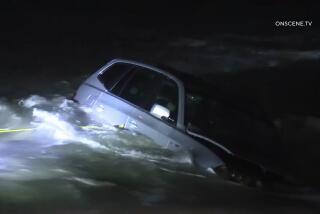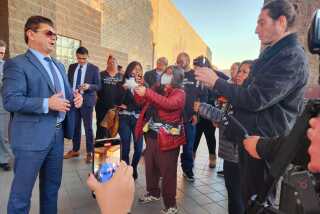Three Cameramen Testify in Denny Case : Trial: All are unable to identify suspects. None willingly surrendered videotapes to authorities; two cite fear of reprisals.
- Share via
Three amateur cameramen who videotaped looting and assaults on motorists near Florence and Normandie avenues last year testified Thursday that they could not identify any individuals photographed while committing crimes at the intersection.
Their ground-level videotapes provide close-up footage of some victims and shots of two men prosecutors say are Damian Monroe Williams, 20, and Henry Keith Watson, 28, who are accused of trying to kill trucker Reginald O. Denny.
Williams and Watson also face multiple felony charges in connection with robberies or assaults on five other motorists and two firefighters who passed through the intersection.
None of the cameramen who testified Thursday willingly surrendered their videotape to authorities. Two testified that they knew investigators would use their footage to identify suspects, and they were afraid that friends of the suspects might retaliate against them for providing evidence.
“A lot of people were upset about the videotapes,” said former Air Force pilot Timothy A. Goldman, who had 2 1/2 hours of tape shot by himself, his brother and a friend on three cameras he owned.
“I knew what authorities would use the tapes for, and I knew that I would be singled out for what was going on,” he said.
Goldman began shooting at Normandie and 71st Street, where an angry crowd had gathered while police made arrests on April 29, 1992. He said he helped a white news photographer--whose camera was taken and car window smashed--get away from the scene after police left, telling the crowd: “He’s only doing his job. Let him go.”
The crowd, which had been shouting obscenities at police, moved to Florence and Normandie after police left, he said, and began throwing rocks and bottles at passing vehicles and assaulting some motorists.
Footage from Goldman, his brother or his friend captured a close-up of Denny, his face a mask of blood, lying on the pavement. They also taped a rock shattering the rear window of a Volvo where an infant was riding in a car seat, and a badly beaten trucker, Larry Tarvin, struggling to his feet and limping to his medical supply van.
A black woman shooting still photographs at the intersection told him she could not understand why blacks were beating Latinos, Goldman said.
On May 2, 1992, Goldman gave a copy of two of his tapes to a journalism student he knew at USC. That student called later, telling Goldman that ABC Television wanted to buy the tapes, and the former pilot sold them to the network, he said.
When the tapes aired, he said, a newscaster said authorities would use his tapes to identify people and make arrests.
“I realized people would be upset,” he said. “I didn’t contact authorities. I didn’t think it was necessary. I don’t have a good relationship with law enforcement.”
Searching for the tapes and allegedly looted liquor, police raided his mother’s home on May 8 and arrested his brother, Goldman said. But his tapes were not there, he said.
Goldman appeared four times before a federal grand jury, but refused each time to turn over the tapes. He did so later on the advice of his attorney.
One reason he did not want to give his tapes to law enforcement, he said, is that he “didn’t appreciate the raid on my mother’s house.”
Reginald R. Brumfield, another amateur photographer at the scene, taped contractor Fidel Lopez, who was beaten unconscious before his pants were pulled down and someone spray-painted his genitals. Brumfield sold his tape to a television show, and police obtained it after discussions with his attorneys, he said.
Mark E. Petty, a Los Angeles Unified School District campus security officer, said he did not come forward with his videotape of attacks at the intersection because he was “afraid of the backlash I’d get from turning it in.”
He sold it to a television station in April, and investigators obtained a copy after coming to his home with a search warrant.
Thursday’s testimony was a prelude to scheduled testimony today from Bob Tur, whose shots from a helicopter hovering above the intersection were broadcast live on KCOP-TV, Channel 13.
More to Read
Sign up for Essential California
The most important California stories and recommendations in your inbox every morning.
You may occasionally receive promotional content from the Los Angeles Times.










